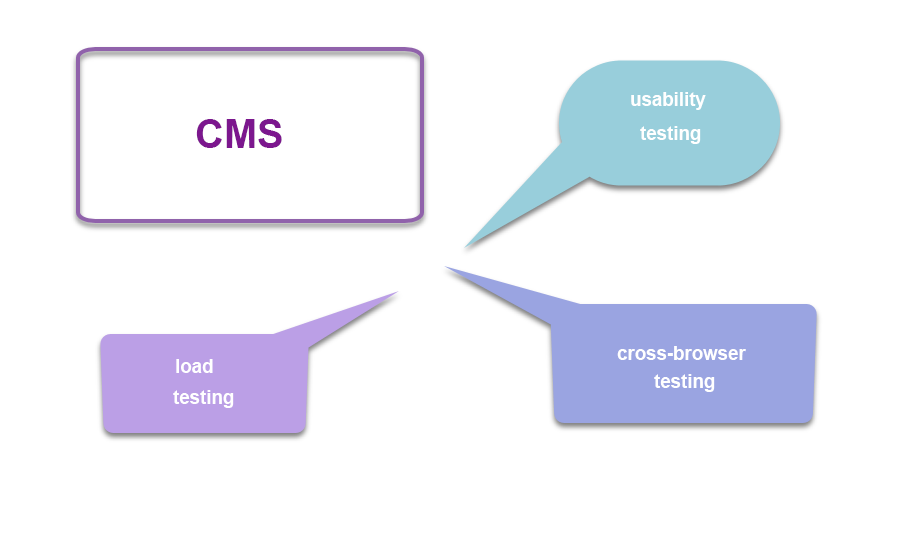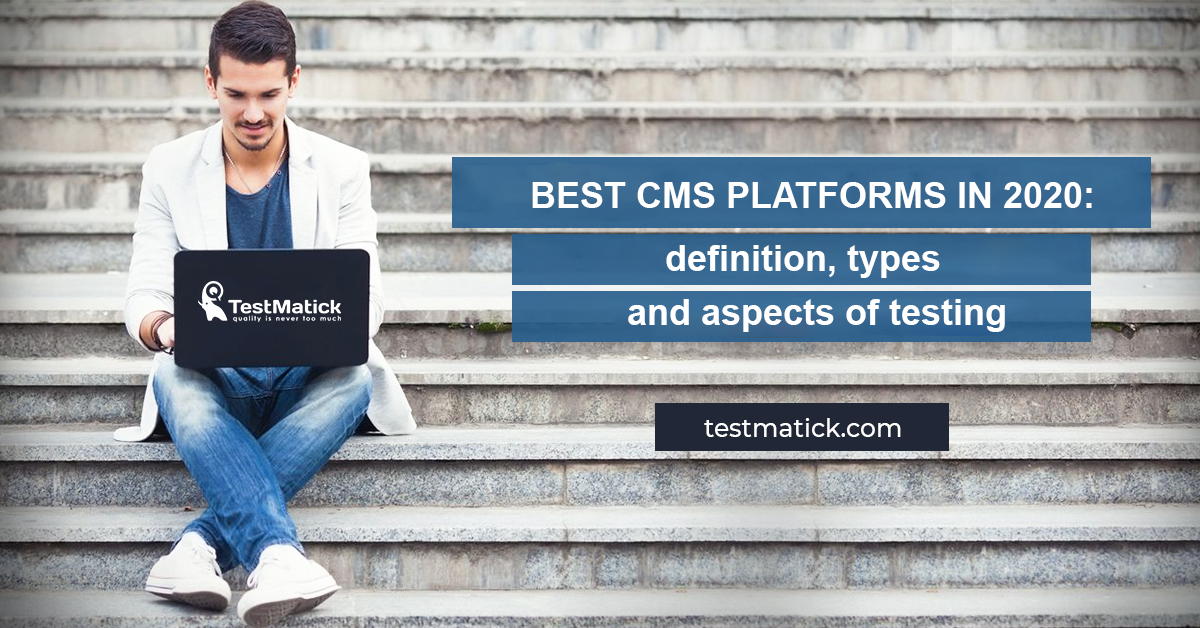Today online shopping is one of the most popular ways to purchase goods and services. Accordingly, an e-commerce market widens and develops annually.
More and more people have the desire to develop their own online store gradually, from the very beginning. But here the following question arises: what is the best way to build a process of managing a huge amount of information?
The directors who came up with the idea to create and support their own online store definitely thought about choosing a management system also. It’s crucial that it should be not only easy and accessible but secure too.
New content management systems, that help to automate more tasks in a short time and at low costs, have replaced manual creation of website content and page layouts. Moreover, they greatly simplify the work with a website and allow communicating with clients.
Content Management System (CMS) – the system of website management, in a form of software package, aimed at automating content publishing, providing the possibility to contact users and exchanging the information between the store and the rest parts of the IT system.
The main advantage of CMS is its easiness of product management. Therefore, CMS can be also called “A website constructor.” We should mention that in such a case, an admin isn’t required to have a technical background.
Every function of CMS has a separate software module that helps to manage or delete it, not impacting the rest functionality.
There are numerous management systems that allow developing a website of almost any type and design. Hence, sometimes it’s hard to select a particular software package.
Further, we’ll talk about the most popular and easy content management systems.
The most popular Content management systems
Joomla!
We can’t mention Joomla! when talking about the most convenient and popular CMS platforms. Frequently, this CMS goes together with WordPress, though it’s not so easy for newcomers to use it, in comparison with WordPress, it can definitely compete with it in terms of flexibility and some other aspects.
Joomla! is used by developers worldwide for developing common websites and complex corporate software.

Joomla Logo
For example, this software is a good choice if you want to manage numerous configured messages. We mean that Joomla! is a good option for those who wish to launch a website with minimum text content.
Also, this system provides numerous options for user management. Thus, Joomla! is a good fit for the products that are based on membership.
Moreover, the platform has multi-language support in its basic version. This means the ability to exclude the necessity of additional extensions when you need to add another language to your website’s control panel.
And finally, Joomla! has the function of simultaneous working with several templates or content themes.
The main advantages of Joomla! CMS:
- supports multiple languages;
- has extended functions of user management;
- supports and offers the templates for each page separately;
- fast and, the main thing, qualitative support of user messages.
Joomla! platform’s features are really great but it has some disadvantages too. When you start working with it, you need to spend much time to study its features and understand how to create a qualitative website on this CMS.
Moreover, Joomla! doesn’t have so many additional templates and extensions as some other similar platforms have.
But this, definitely, doesn’t’ mean that you shouldn’t use it. You just need to have enough experience in development, to implement some functions manually.
WordPress
It’s considered as one of the leading management platforms, that occupies the first places of development markets, and there are some reasons for this.
Primarily, the main function of this system was to manage blogs but it was upgraded in some time, improved and nowadays, it has much more functions than it had in the beginning.
WordPress is easily configured and is quite simple. WordPress gives the possibility to register on a website, its versions are frequently updated and there is a huge community of its users.

WordPress Logo
The main advantages of WordPress CMS:
- simple configuration and installation;
- fast publication loading;
- themes are made with the help of PHP templates, and this increases the platform’s speed and flexibility;
- supports XTML, CSS standards;
- provides numerous ways to enter the information;
- supports the themes that are used for changing web page design;
- has a big community of its users;
- established capacity of its architecture, that can help to easily implement complex solutions;
- a wide range of extensions and plug-ins;
- has an editor that allows editing and deleting the data;
- easy and clear variants of content managing.
And one of the disadvantages of WordPress is that it’s hard to add accurate functions to a website by comparing and mixing different themes and templates.
But in such a case, you can use other types of content management systems that provide better ways of managing blogs and websites but can’t completely be configured in the same way as WordPress does.
Drupal
It’s also an important platform for developing not only websites but web programs, that use it as a base. It’s written in PHP. Data are stored in a relational database.
Drupal can be used for creating the websites for big companies, political and state organizations, personal blogs.
Though this platform is a little bit worse than WordPress and Joomla!, is in some way better than Joomla! (we are talking now about the flexibility of configuring the message types, Joomla! definitely works here worse than Drupal).
Drupal CMS has a high level of controlling the website visitors, has the function of processing multi-language web products in its primary versions. It’s not all the advantages of this content management system.
Drupal has more advantages, for example, it’s considered more secure than WordPress and Joomla!

Drupal Logo
Main advantages of Drupal CMS:
- the function of searching within the content;
- there is only one categorization for all types of content;
- a high level of security;
- the function of adding the categories of any type of depth;
- supports multiple languages, the possibility to translate a website into more than 100 international languages;
- has short URLs;
- has extended parameters for managing website visitors and extensions.
- the possibility to control the load;
- the flexibility of the system, the function to create user messages;
- if there is a big load on a website, some information modules can be automatically switched off.
Drupal is a platform that can be used for creating almost any website. It’s easily scaled, quite secure, so it is perfect for developing corporate and business websites.
But there is one disadvantage: this CMS is very complex. If a developer doesn’t have experience with it, he/she has almost no chance to develop a qualitative product.
Where content management systems can be used
Ready and convenient CMS platforms, that have a certain list of functions, can be used in different ways in the IT field.
They are mostly used:
- For writing and supporting the blogs. We mean managing a blog with a different type of content (like text, photos or videos). Drupal and WordPress will be a good choice for such tasks;
- For developing the landing pages. Landing page – it’s the websites that consist of one page. They are used for advertising or for redirecting a user to a particular webpage or a website. WordPress and Joomla! will be the best option for such tasks.
- For creating online stores. Since many of us would like to create our own online store, it’s very important to properly choose a CMS. A platform should be flexible and offer the following functions: fast processing of orders, support of product catalogs online, provide a cart, various ways of paying and delivering an order. To properly choose a CMS, you should study the functionality and capability of different platforms.
- For developing business card sites. Frequently, such products contain information on the company. They should be simple and convenient, have the short description of a company, its field of usage, contact information and similar important information of such a type;
- For creating corporate websites. A corporate website is in some way similar to a business card website but is much more complex. It has a huge amount of information, has the function of working with users, the function of processing the orders and organizing feedback with customers.
The process of testing the content management systems
Since modern CMS platforms have a wide functionality, the time of user response may increase and this can spoil the impression from a website, even if it’s really good and qualitative. To not meet such situations, you should spend a lot of energy and time on testing as one of the most important stages of website development.
Testing will help you to find weak spots of a product and make it completely qualitative. It’s very important to perform testing at every stage of development.
Besides load tests that provide constant stability of the product’s functioning, you shouldn’t forget about cross-browser tests and usability tests.

CMS Testing Process
Load testing
The main aim of load testing is to define the load when a web program works well and also to fix the issue if there is a high load.
When the weak areas of application are defined, it can be configured in such a way that the user response time will completely decrease and this will, in turn, have a positive impact on the first impression from the product.
Load tests mean testing a program at a high load, to define complete throughput (a number of user requests that are processed in a particular amount of time).
A right way of finding the users that are processed simultaneously is finding the answers to the following questions:
- How many users should be on a website in a particular amount of time?
- What a user can do on a website in a particular time range?
To solve these questions, you should use special applications that steal and evaluate the actions of the users that are using the product. They help to simulate a particular number of users and get a general result for all users at the end of testing. When analyzing this text, you receive an accurate level of website stability and website time response.
In most cases, the following utilities are used for load tests: Selenium, JMeter, Grinder, and others.
Usability testing
This type of testing helps to analyze the program from the user’s side, and if there is such need, the resource is simplified and its interface is made clearer and more convenient for a user.
A website should meet the following requirements:
- The content is clear, doesn’t contain complex terms and complex texts;
- Is simple and has a simple structure;
- It’s easy to return back if a user makes some mistakes;
- customer should freely navigate through the pages, has no difficulty in finding the information he/she is looking for.
The following online services can be used for website usability testing: UsabilityHub, UserPlus, Usabilla, OptimalWorkshop, Feng-Gui, ClickHeat.
Cross-browser testing
Cross-browser tests help to see how a website is displayed in various browsers.
It’s a very important stage in testing since a customer can use various browsers for working with a product and the product should work properly in each of them.
Frequently, the same page is displayed in different ways and this may happen due to the absence of one template.
Cross-browser testing is executed manually on virtual machines where all possible browsers and their versions have been installed. Moreover, the following applications may help to perform such testing: Thumbalizr, NetRenderer, Browserling, Browsershots, Lunascape, SuperPreview, Browser Sandbox Adobe BrowserLab.
Conclusion
Content Management Systems – it’s the platforms that become more and more popular every day thanks to its constant improvement, simplicity in product development and management of pages, blogs, websites of various target groups. To make the quality of the products you are creating really high, it’s important to test them in time.










Leave A Comment